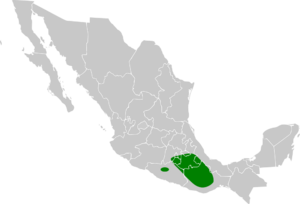Boucard's wren facts for kids
Quick facts for kids Boucard's wren |
|
|---|---|
 |
|
| Conservation status | |
| Scientific classification | |
| Genus: |
Campylorhynchus
|
| Species: |
jocosus
|
 |
|
The Boucard's wren (Campylorhynchus jocosus) is a small bird that belongs to the Troglodytidae family, also known as wrens. This special bird lives only in Mexico, meaning it is endemic to that country.
Contents
Meet the Boucard's Wren
What Makes This Bird Special?
Scientists once thought the Boucard's wren might be the same as another bird, the spotted wren. But new studies looking at their DNA showed they are actually quite different. The Boucard's wren is also monotypic. This means it is the only species in its particular group, or genus, that scientists have found so far.
How to Spot a Boucard's Wren
Boucard's wrens are about 17 cm (6.7 in) long. That's about the length of a regular pencil! They weigh between 23.8 to 29.8 g (0.84 to 1.05 oz), which is lighter than a few quarters.
Male wrens have a dark brown top of the head and a reddish neck. Their shoulders are blackish with white stripes, and their back is reddish-brown with black and white spots. The lower back is a dull reddish color. Their tail is gray-brown with dark stripes, and the very tips of the outer feathers are white.
They have a light stripe above their eye and a dark stripe through it. The rest of their face is dark gray. Their chin and throat are plain white, and their belly is white with black spots. The sides of their body are a light brown color with darker stripes.
Female wrens look very similar to males. The main difference is that the spots on their belly are usually smaller. Young wrens have less clear markings on their back. Their throat might have speckles, and their belly is grayish with dull, blurry spots.
Where Boucard's Wrens Live
Finding Their Home in Mexico
Boucard's wrens live in the south-central part of Mexico. You can find them in the states of Puebla, Morelos, Guerrero, and Oaxaca.
Their Favorite Places to Live
These wrens prefer dry forests, sometimes with very tall cacti. They like areas with pine and oak trees, or just oak bushes. They also live in subtropical scrublands. These birds are very good at living in places where humans have changed the habitat.
They usually live at elevations from 800 to 2,500 m (2,600 to 8,200 ft) above sea level. That's like living high up in the mountains! But sometimes, they can be found as low as 600 m (2,000 ft).
Boucard's Wren Behavior
What Do They Eat?
Boucard's wrens look for food from the ground all the way up to the tops of trees and cacti. However, they don't often search for food directly on the ground. Their diet includes both animals and plants. They love to eat insects and seeds from cacti.
How Do They Raise Their Young?
People have seen Boucard's wrens building nests in April. Nests with eggs have been found in Oaxaca between mid-June and early July. Their nests are shaped like domes with an entrance on the side. A female wren usually lays three to four eggs at a time.
What Do They Sound Like?
The song of the Boucard's wren is described as "a series of grating notes" [1]. They also make a "harsh rapid chatter" [2]. Both the male and female wrens sing together.
Boucard's Wren Status
Are They Safe?
The IUCN (International Union for Conservation of Nature) has looked at the Boucard's wren. They have decided that this bird is of "Least Concern." This means they are not currently worried about the species becoming endangered.
Scientists estimate that there are at least 20,000 Boucard's wrens. Their numbers are believed to be stable, which is good news for these unique Mexican birds!


